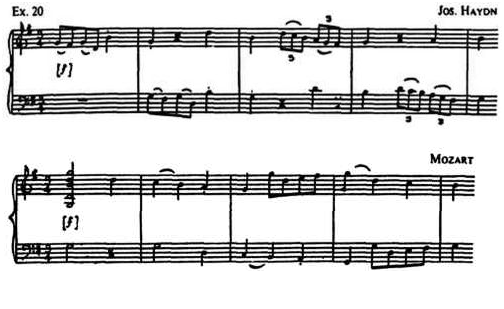“Mozart and counterpoint“ (excerpt 2).
From: Mozart. His character and works. By Alfred Einstein.
(Translated from „Mozart und der Kontrapunkt“, by Einstein, Alfred: Mozart. Sein Charakter, sein Werk. Zürich, Stuttgart 31953, S. 174-189. Lizenz: verwaist/ License: abandoned. source link: Mozart. Sein Charakter, sein Werk. — Mozart und der Kontrapunkt)
By Edward Eggleston
(This 2nd excerpt continues the discussion of Mozart’s early compositions and training with an emphasis on counterpoint.)
… In Mozart’s G major Cassation from the spring of 1769, we already find a minuet in which the basses follow upper strings in canon, by a one measure distance. This is an exact imitation of the minuet from Joseph Haydn’s G major Symphony (No. 23) of 1764; it is likely Mozart heard this work in Vienna:

A similar though small artistic display is found in the minuet of the G Major Symphony of July 1771 (K. 110). In this case, the canonic voice followed in the subdominant. This freedom of treatment reflects already a higher level of skill.
For between these examples from 1764 and 1771, Mozart studied the older and stricter polyphony in Bologna, with Padre Giambattista Martini. Thus in spring and fall of 1770, Martini gave Mozart canonic exercises to complete. Although somewhat colorless, such canons were part of Martini’s own attainment in composition, and are found as vignettes in his music history treatises. It is possible the elderly Franciscan was alone in his time in having a true and thorough understanding of the past polyphonic vocal style. Thus the exercises for Mozart were offered with a certain authority, aimed at providing a similar direct experience with the older polyphony.
Between these visits to Bologna, Mozart had a related opportunity in Florence. Here he became familiar with the Stabat Mater of the Marchese di Ligniville, music director of the grand duke. Mozart was either greatly impressed or at least moved to great effort: this composition in canonic form represents an extremity of contrapuntal execution [“den knöchersten Kontrapunkt der Welt”], and the young composer copied out not less than nine sections. This is similar to the effort Mozart made in copying and solving “puzzle canons” from Padre Martini’s “Storia della musica”.
The exercises from Padre Martini were also preparation for Mozart’s (much sought) acceptance in the famous Accademia filarmonica in Bologna, on 10 October 1770. The requirements for acceptance were demanding. The candidate was given a segment of Gregorian chant, to which three upper voices in the strictest style (in “stile osservato”) were to be added. Mozart was given an antiphon melody for his examination. He did not pass the test. All of Leopold Mozart’s extravagant claims of a glorious musical result have proven false. This is shown by three documents in the Accademia filarmonica and Liceo Musicale archives in Bologna. These reveal the events: the original exam completed by Mozart, the correction by Padre Martini, and Mozart’s next copy including these corrections. The final copy was presented to the jury.
The verdict, despite the help from the good Padre Martini, was not enthusiastic: “In less than an hour”, (Leopold spoke of 30 minutes) “Signor Mozart presented his attempt, which in consideration of the special circumstances has been found sufficient.” [“Nel termine di meno d’un’ora ha esso Sr. Mozart portato il suo esperimento, il quale riguardo alle circostanze di esso lui è stato giudicato sufficiente.”]
The judgment was humane, mild, and shows a certain intuitive insight. Mozart’s artistic growth and achievement justify the instinctive sense of the jury. The Accademia filarmonica can hardly claim a greater member, to list with some pride, than Wolfgang Amadeus Mozart. [In any case,] Mozart quickly forgot the experience in Bologna. Whether authentic or archaic, the style of the 16th century was not important to him. He could imitate any composer or style; and did not feel a need to imitate Palestrina – at least as a direct model for composition.
(To be continued)
